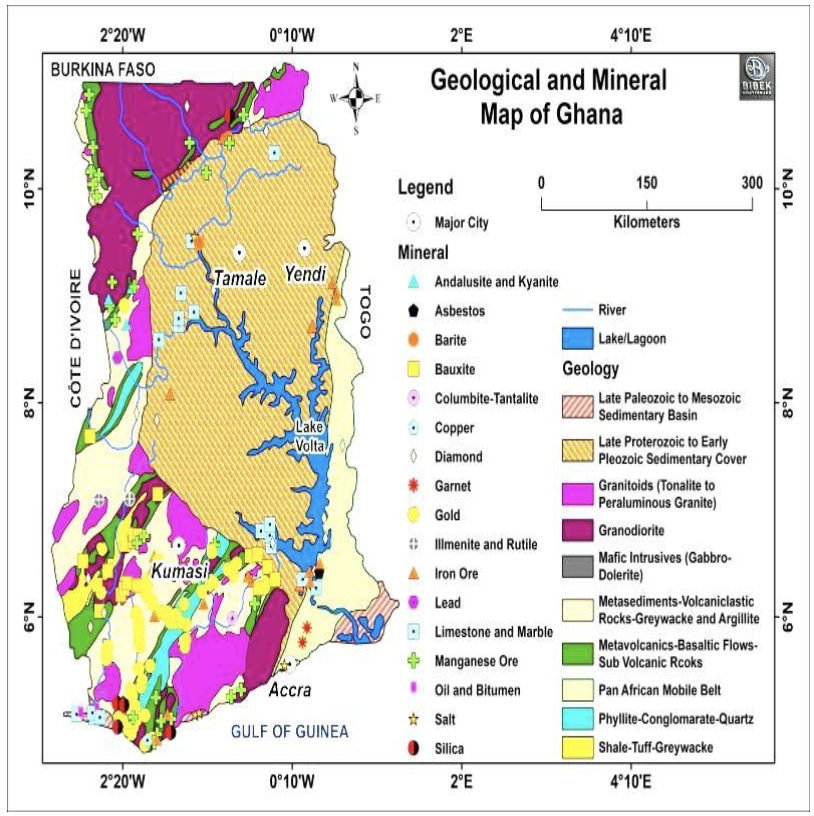Galamsey as an asset and a menace in the Ghanaian space economy
DOI:
https://doi.org/10.71113/JMSS.v2i4.253Keywords:
Galamsey, Asset, Menace, GhanaAbstract
Illegal small-scale mining, popularly referred to as galamsey, is a long-standing issue in Ghana, impacting its economy and environment. While it provides livelihood opportunities, it threatens sustainable land use, environmental health, and socio-economic stability. The complexity of this activity has created debate regarding its value as an economic asset and threat. This paper examines the dual role of galamsey as an asset and a menace in Ghana's economy. The paper adopted a systematic review approach to examine the impact of galamsey on land use, governance, and livelihoods. The study concludes that the social and environmental costs of galamsey are higher than their economic benefits. The need arises for strict policies, sustainable land-use planning, and community action to arrest these impacts.
References
Africa (2024). "Ghana mining advantages include increased gold production and regulatory updates - Africa 2024 - Oxford Business Group". oxfordbusinessgroup.com.
Afriyie, R. Z., Arthur, E. K., Gikunoo, E., Baah, D. S., & Dziafa, E. (2023). Potential health risk of heavy metals in some selected vegetable crops at an artisanal gold mining site: A case study at Moseaso in the Wassa Amenfi West District of Ghana. Journal of Trace Elements and Minerals, 100075. https://doi.org/10.1016/j.jtemin.2023.100075
Akyeampong, E., & Xu, L. (2023). Chinese technology and the transformation of the rural economy in Ghana: Evidence from Galamsey in the Ashanti and Savannah regions. African Affairs, 122(448), 329-351. https://doi.org/10.1093/afraf/adad023
Aryee, B. (2001). Ghana's mining sector: Its contribution to the national economy. Resources Policy, 44, 1 10. https://doi.org/10.1016/S0301-4207(00)00042-8
Bessah, E., Raji, A. O., Taiwo, O. J., Agodzo, S. K., Ololade, O. O., Strapasson, A., & Donkor, E. (2021). Gender-based variations in the perception of climate change impact, vulnerability, and adaptation strategies in the Pra River Basin of Ghana. International Journal of Climate Change Strategies and Management, 13(4/5), 435–462. https://www.emerald.com/insight/content/doi/10.1108/IJCCSM-02-2020 0018/full/html
Bibek (2025). Mineral Deposits of Ghana. https://www.linkedin.com/in/bibek-1993?lipi=urn%3Ali%3Apage%3Ad_flagship3_profile_view_base_contact_details%3BOZ4LymIcRduFO27GhtxBmQ%3D%3D
Boutilier, R. G., & Thomson, I. (2011). Social License and the Resource Sector. Journal of Business Ethics, 101(2), 243-267.
Bryceson, D. F., & Geenen, S. (2016). Artisanal frontier mining of gold in Africa: Labour transformation in Tanzania and the Democratic Republic of Congo. African Affairs, 115(459), 296-317.
Cernea, M. M., & McDowell, C. (2000). Risks and Reconstruction: Experiences of Resettlers and Refugees. World Development, 28(5), 827-849.
Donkor, P., Siabi, E. K., Frimpong, K., Mensah, S. K., Siabi, E. S., & Vuu, C. (2023). Socio demographic effects on role assignment and associated occupational health and safety issues in artisanal and small-scale gold mining in Amansie Central District, Ghana. Heliyon, 9(3). https://www.cell.com/heliyon/pdf/S2405-8440(23)00948-9.pdf
Esdaile, L. J., & Chalker, J. M. (2018). The Mercury Problem in Artisanal and Small‐Scale Gold Mining. Chemistry – A European Journal, 24(27), 6905–6916. https://doi.org/10.1002/chem.201704840
Fortin, J.-L., Desmettre, T., Manzon, C., Judic-Peureux, V., Peugeot-Mortier, C., Giocanti, J.-P., Hachelaf, M., Grangeon, M., Hostalek, U., & Crouzet, J. (2010). Cyanide poisoning and cardiac disorders: 161 cases. The Journal of Emergency Medicine, 38(4), 467–476. https://doi.org/10.1016/j.jemermed.2009.09.028
Gbireh, A. B., Cobblah, A., & Suglo, R. S. (2009). Analysis of the trends of gold mining in Ghana. Ghana Mining Journal, 9(1), 38–49. https://doi.org/10.4314/gm.v9i1.42608
Ghana Chamber of Mines. (2021). Annual report 2020: Performance of the mining sector. Ghana Chamber of Mines. "THE GHANA CHAMBER OF MINES 2021 MINING INDUSTRY STATISTICS AND DATA" (PDF).
Ghana Environmental Protection Agency. (2019). Environmental performance rating and disclosure report for mining companies in Ghana. https://www.epa.gov.gh/
Ghana Extractive Industries Transparency Initiative. (2021). 2019 Mining sector report. https://gheiti.gov.gh/site/
Ghana Extractive Industries Transparency Initiative. (2021). Annual report on mining revenue and governance challenges in Ghana.
Gilbert, D., & Albert, O.-B. (2016). Illegal small-scale gold mining in Ghana: A threat to food security. Journal of Food Security, 4(5), 112–119. DOI:10.12691/jfs-4-5-2
Hilson, G. (2002). Small-scale mining and its socio-economic impact in developing countries. Natural Resources Forum, 26(1), 3-13.
Hilson, G. (2009). Small-scale mining, poverty and economic development in sub-Saharan Africa: An overview. Resources Policy, 34(1-2), 1-5. https://doi.org/10.1016/j.resourpol.2008.12.001
Hilson, G. (2012). The nature, impact and management of mining conflicts in Ghana. Journal of Cleaner Production, 29-30, 53-59.
Hilson, G., & Hilson, A. (2015). Entrepreneurship, poverty and sustainability: Critical reflections on the formalisation of small-scale mining in Ghana. International Growth Centre. Retrieved from https://www.theigc.org/sites/default/files/2015/04/Hilson-Hilson-2015-Working-Paper-1.pdf
Hilson, G., & Maconachie, R. (2020). Artisanal and small-scale mining governance in Ghana. Journal of Mining Policy, 17(3), 101-120.
Hirons, M. (2020). How the sustainable development goals risk undermining efforts to address environmental issues in Sub-Saharan Africa. World Development, 127, 104-108.
Intergovernmental Forum on Mining. (2018). Global trends in artisanal and small-scale mining: A review of key issues. IGF. https://www.igfmining.org/global-trends-in-artisanal-and-small-scale-mining-a-review-of-key-issues/
International Finance Corporation (IFC). (2015). Performance Standards on Environmental and Social Sustainability.
Lacey, N., & Rawlinson, A. (2011). Securing the Social License to Operate: Cases in Global Mining. Corporate Social Responsibility and Environmental Management, 18(6), 343-354.
Mensah, E. O., & Darku, E. D. (2021). The impact of illegal mining on public health: A case study in kenyasi, the ahafo region in Ghana. Technium Soc. Sci. J., 23, 1. https://techniumscience.com/index.php/socialsciences/article/view/4503
Owusu, K. (2021). Land use transformation and spatial economy in Ghana: Challenges and prospects. African Geographical Review, 40(2), 223-240.
Owusu-Nimo, F., Mantey, S. D., Nyarko, K. B., Appiah-Effah, E., & Aubynn, A. (2018). The impact of Chinese involvement in small-scale mining in Ghana. Resources Policy, 55, 49-56.
Rajaee, M., Obiri, S., Green, A., Long, R. N., Cobbina, S. J., Nartey, V., Buck, D., Antwi, E., & Basu, N. (2015). Integrated assessment of artisanal and small-scale gold mining in Ghana—Part 2: Natural sciences review. International Journal of Environmental Research and Public Health, 12(8), 8971-9011. https://doi.org/10.3390/ijerph120808971
Reuters. (2024). Gold mining in Ghana: Booms and environmental consequences. Reuters News.
Sarpong, C. K., Dinye, R. D., & Elizabeth, S. (2025). Managing land use disputes in mining areas in Sub-Saharan Africa. Journal of Modern Social Sciences, 2(3), 215–225. https://doi.org/10.71113/JMSS.v2i3.188
Sebiawu, G. E., Antwi-Akomeah, S., Mensah, N. J., & Abana, D. (2020). Heavy metal and bacteriological contamination of herbal medicines sold over the counter in the municipality of wa of the upper West Region-Ghana. International Journal of Scientific Research in Multidisciplinary Studies, 6(5), 15-23. https://www.isroset.org/journal/IJSRMS/full_paper_view.php?paper_id=1889#pare ntHorizontalTab3
Takyi, R., Hassan, R., El Mahrad, B., & Adade, R. (2021). Socio-ecological analysis of artisanal gold mining in West Africa: A case study of Ghana. Journal of Sustainable Mining, 20(3), Article 6. https://doi.org/10.46873/2300-3960.1322
Wiafe, S., Awuah Yeboah, E., Boakye, E., & Ofosu, S. (2022). Environmental risk assessment of heavy metals contamination in the catchment of small-scale mining enclave in Prestea Huni-Valley District, Ghana. Sustainable Environment, 8(1), 2062825. https://doi.org/10.1080/27658511.2022.2062825
World Bank. (2011). Involuntary Resettlement. Environmental and Social Framework.
World Bank. (2020). Ghana mining sector development and environment project. https://projects.worldbank.org/en/projects-operations/project-detail/P147862
World Bank. (2020). Global trends in foreign direct investment in the mining sector. World Bank Group.
World Gold Council. (2015). The economic contribution of large-scale mining to Ghana’s GDP and employment. World Gold Council. https://www.gold.org/goldhub/research/economic-contribution-large-scale-gold-mining-ghanaWorld Gold Council. (2021). The economic impact of gold mining: Global contributions and financial stability. World Gold Council Reports.
Yeboah, S. A., & Nyarkoh, B. J. (2022). The impact of mining on the Ghanaian economy: A comprehensive review (1992-2020). Munich Personal RePEc Archive (MPRA). https://mpra.ub.uni-muenchen.de/117502/
Yen, Y.-P., Tsai, K.-S., Chen, Y.-W., Huang, C.-F., Yang, R.-S., & Liu, S.-H. (2012). Arsenic induces apoptosis in myoblasts through a reactive oxygen species-induced endoplasmic reticulum stress and mitochondrial dysfunctio n pathway. Archives of Toxicology, 86(6), 923–933. https://doi.org/10.1007/s00204-012-0864-9

Downloads
Published
How to Cite
Issue
Section
License
Copyright (c) 2025 Christian Kofi Sarpong, Prof. Dr. Romanus Dinye

This work is licensed under a Creative Commons Attribution 4.0 International License.


























